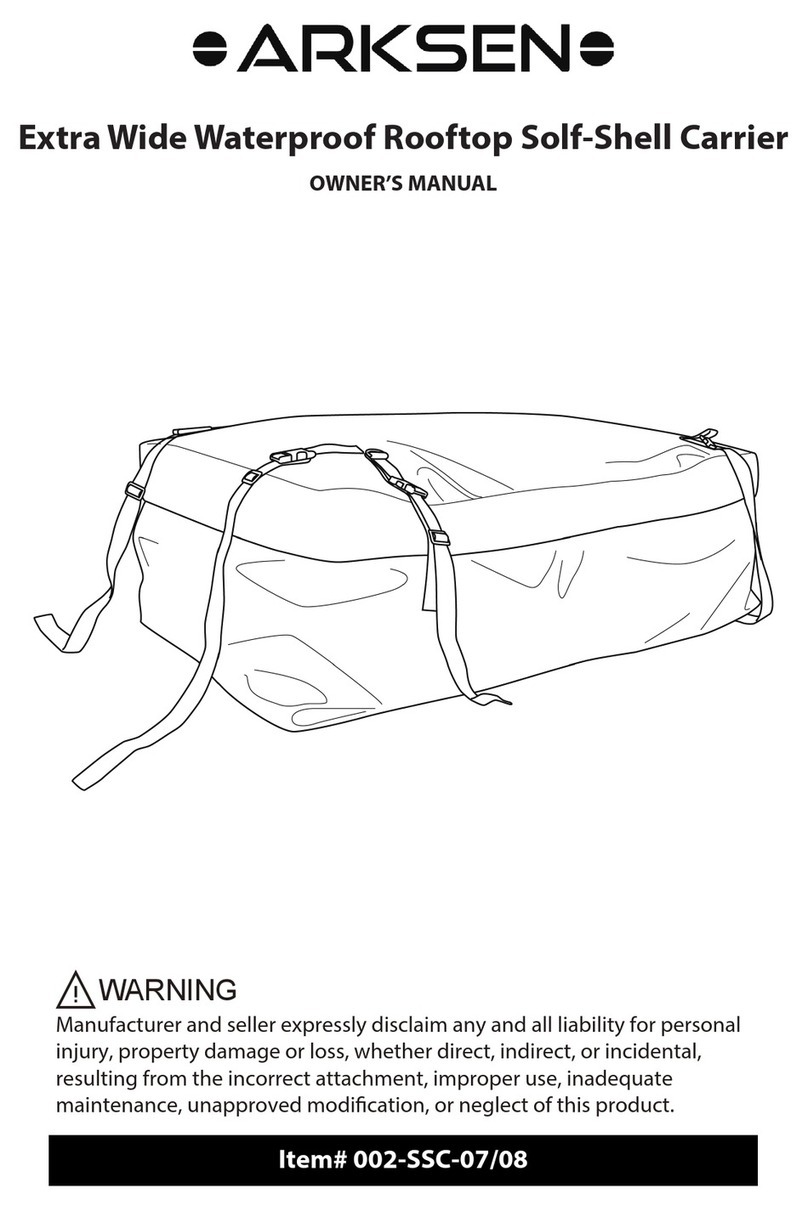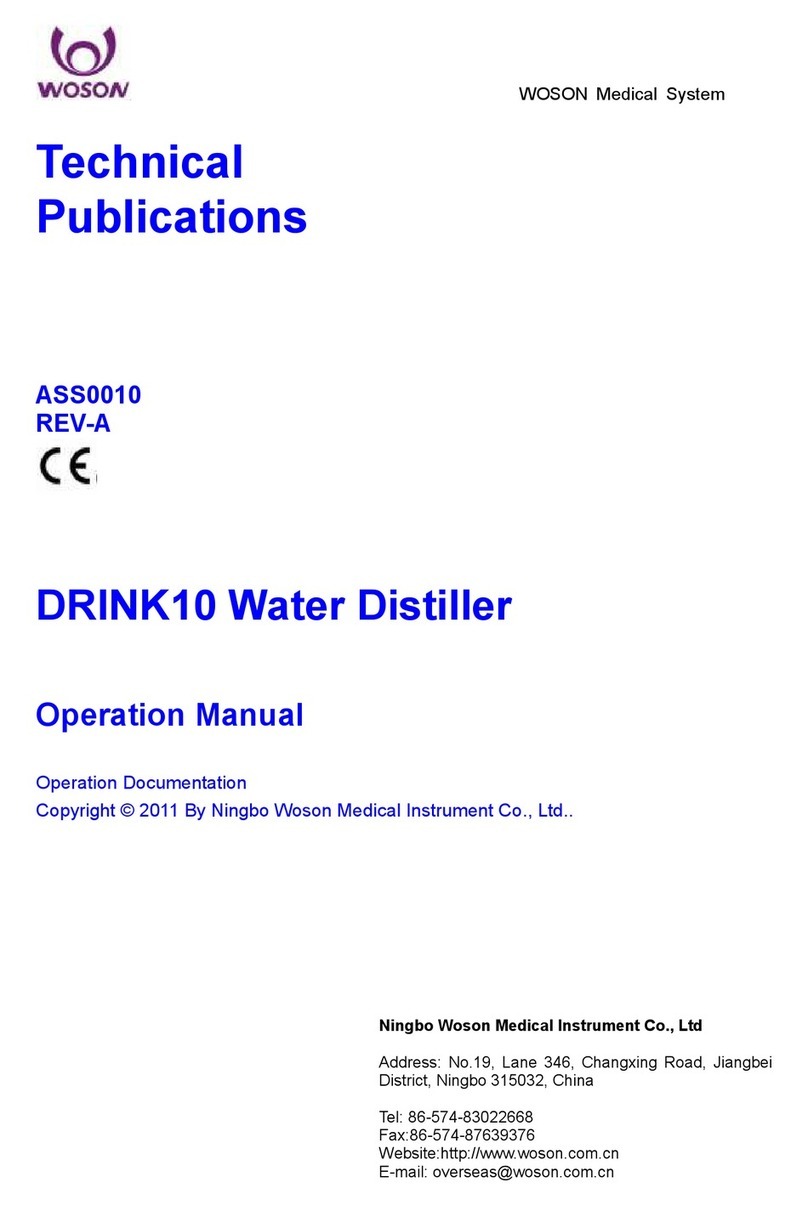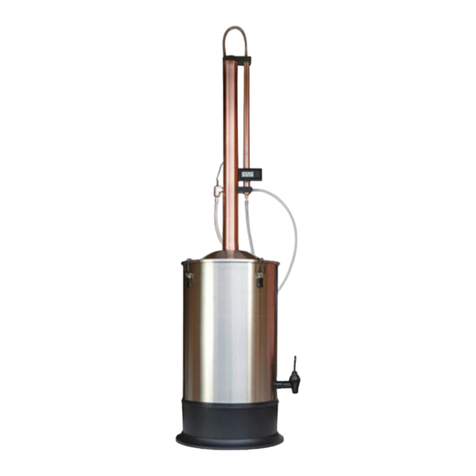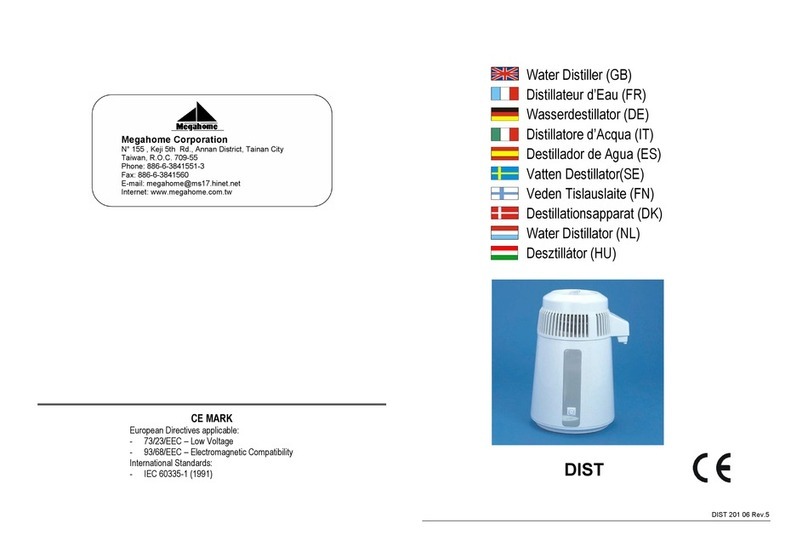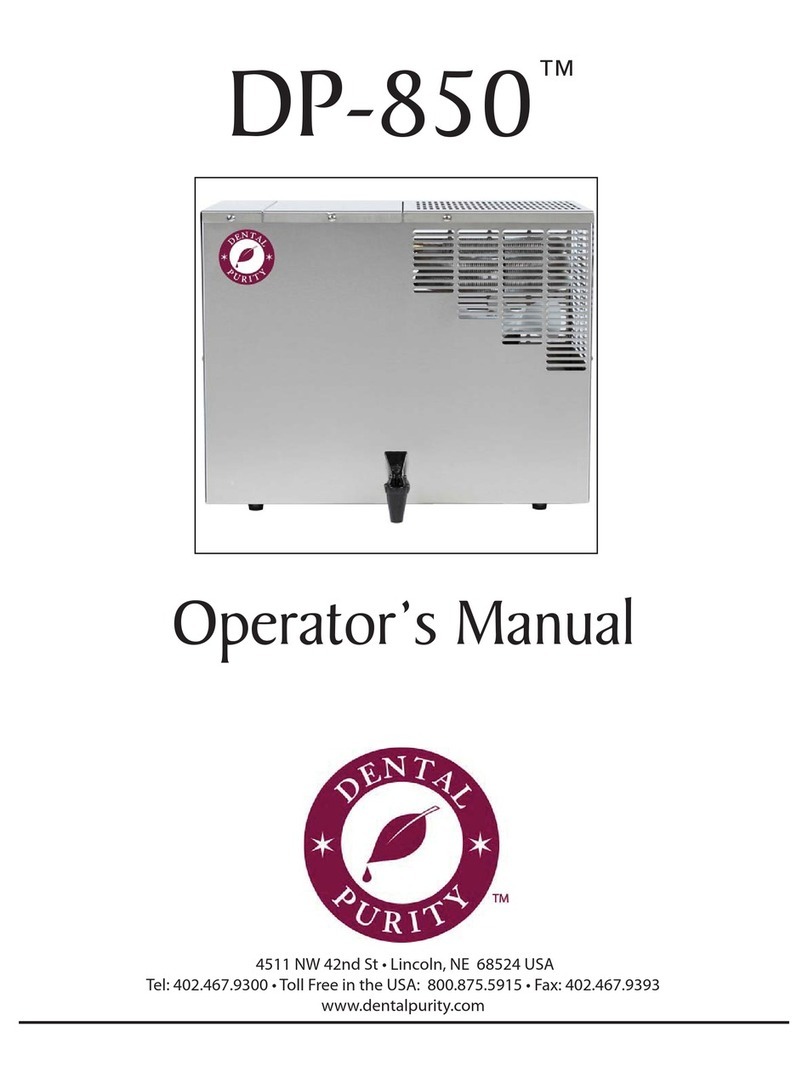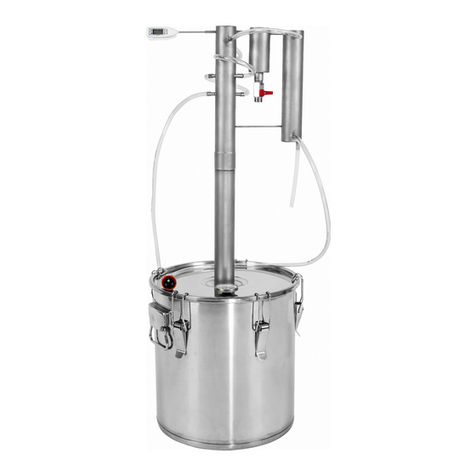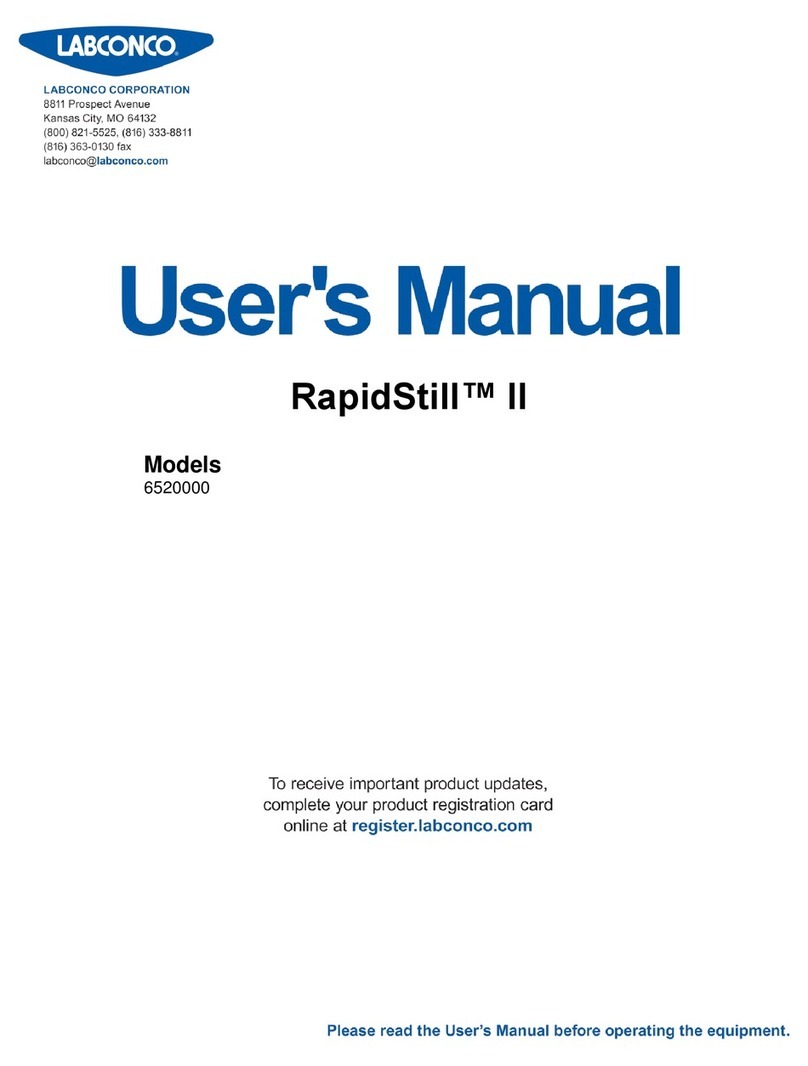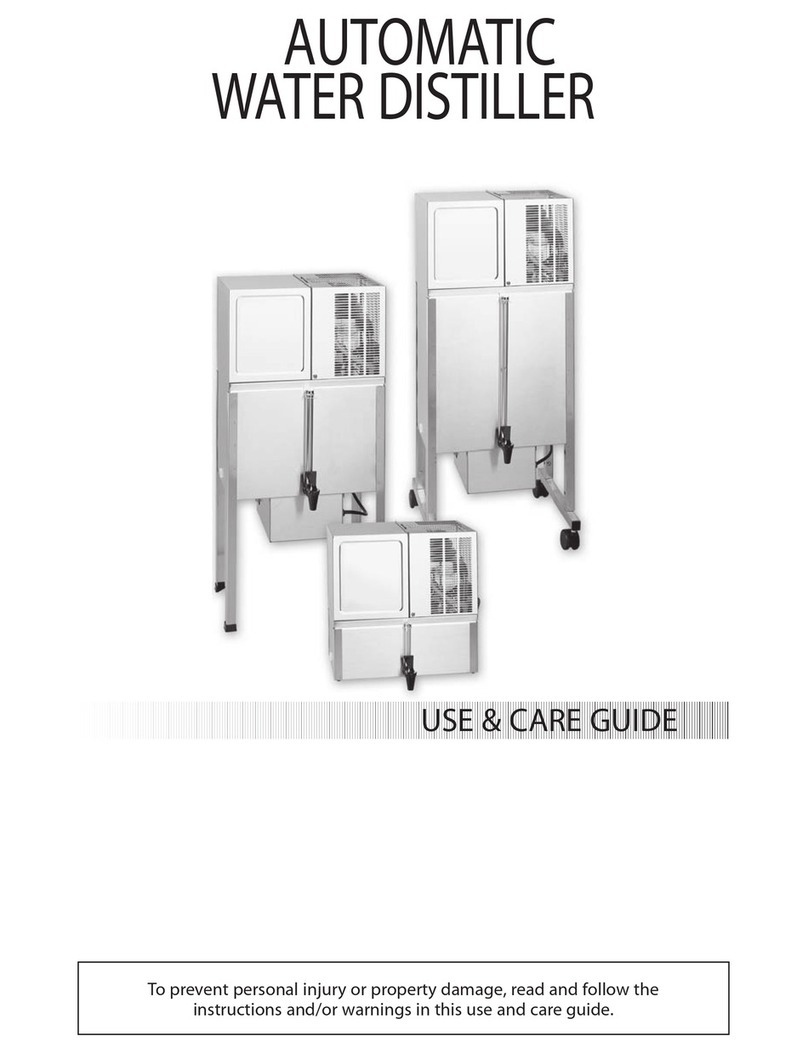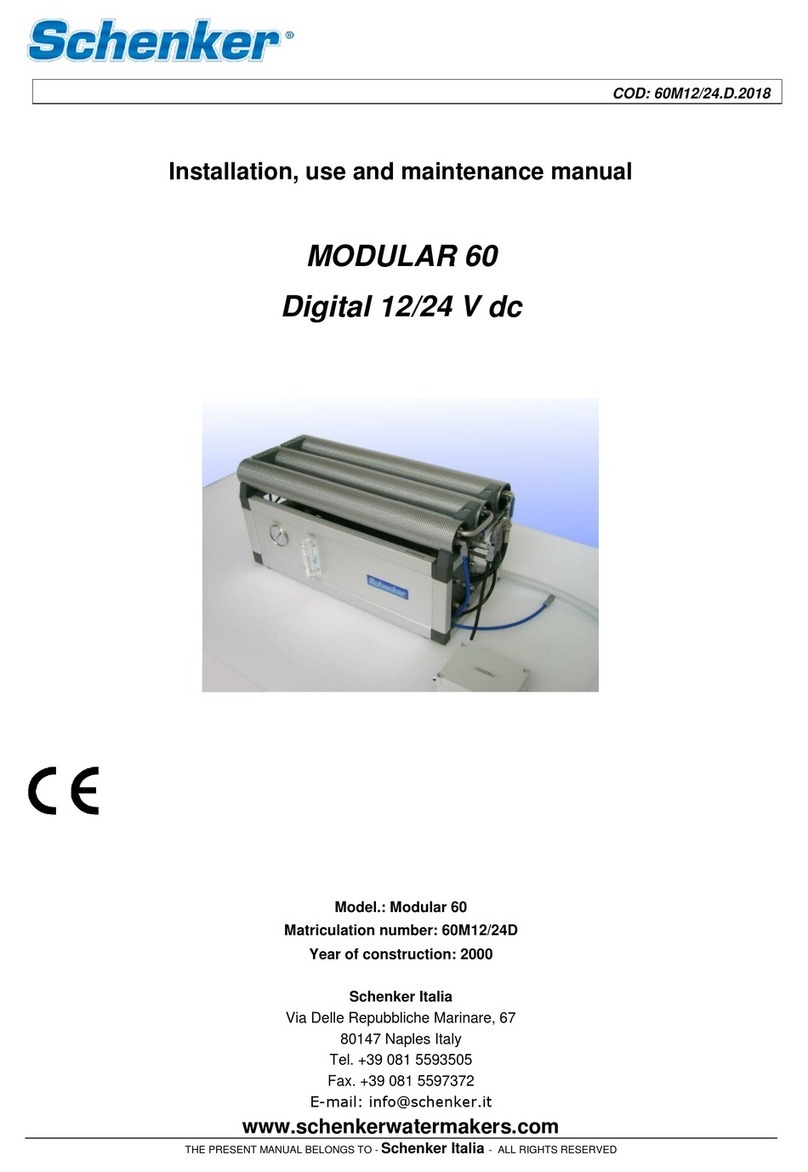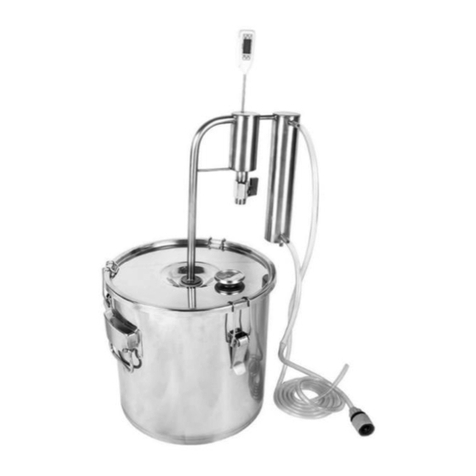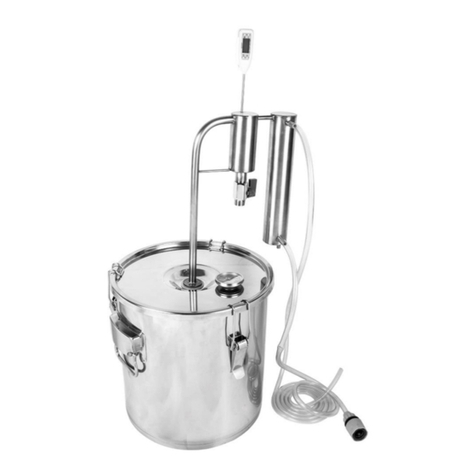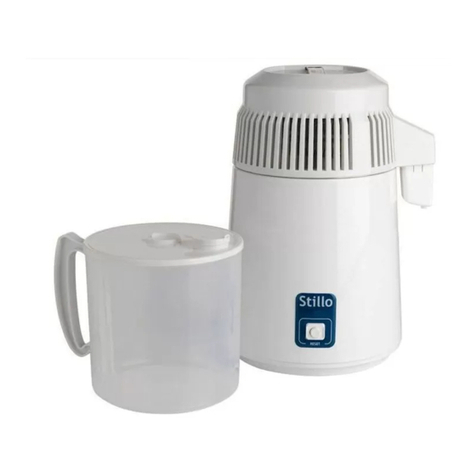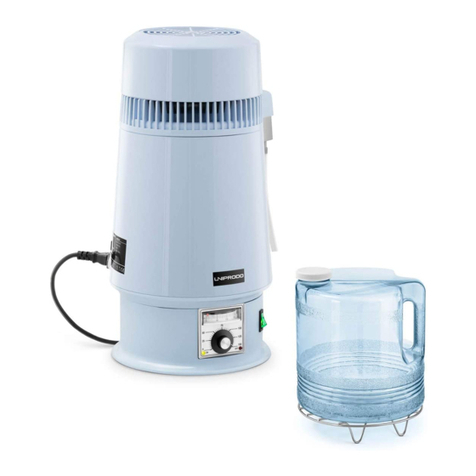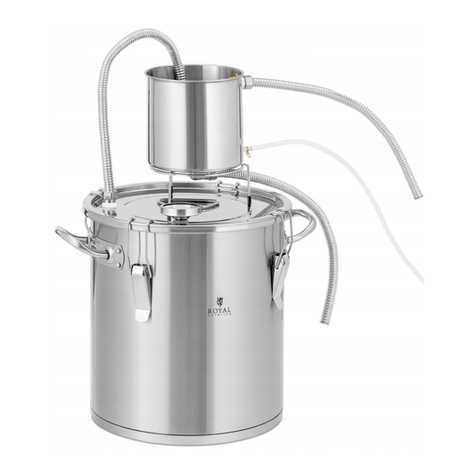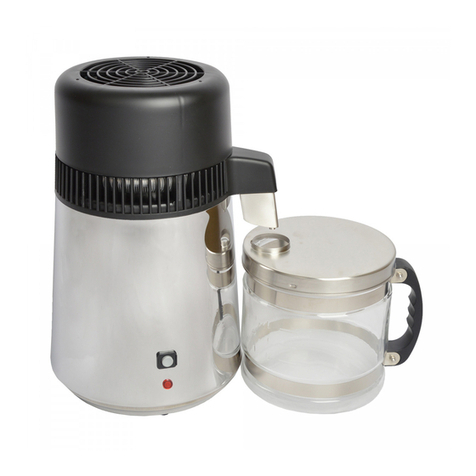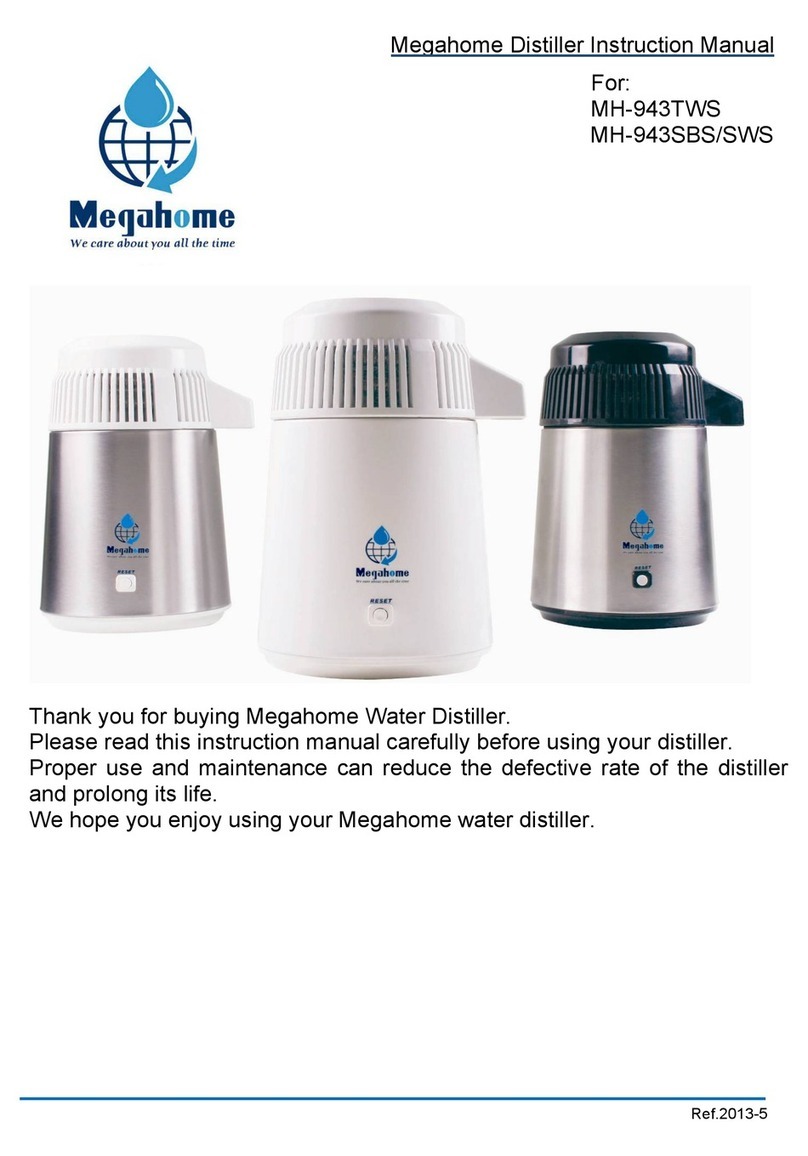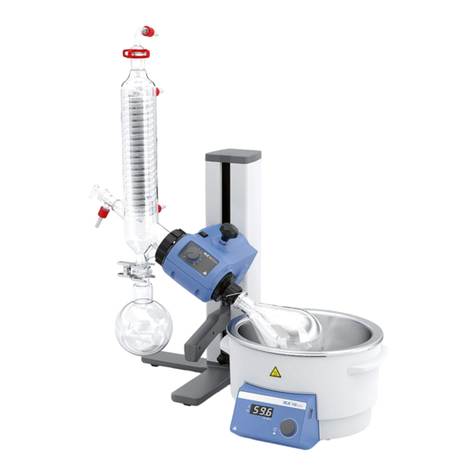Buchi Rotavapor R-250 Pro User manual

Rotavapor® R-250 Pro
Operation Manual
11594225 | A en

Imprint
Product Identification:
Operation Manual (Original) Rotavapor® R-250 Pro
11594225
Publication date: 05.2021
Version A
BÜCHI Labortechnik AG
Meierseggstrasse 40
Postfach
CH-9230 Flawil 1
E-Mail: [email protected]
BUCHI reserves the right to make changes to the manual as deemed necessary in the light of experience,
especially with respect to structure, illustrations and technical details.
This manual is copyrighted. Information from it may neither be reproduced, distributed, or used for
competitive purposes, nor made available to third parties. The manufacture of any component with the
aid of this manual without prior written agreement is also prohibited.

Büchi Labortechnik AG Table of contents
Operation Manual Rotavapor® R-250 Pro iii
Table of contents
1 About this document...........................................................................................................6
1.1 Mark-ups and symbols ..........................................................................................................6
1.2 Trademarks ...........................................................................................................................6
1.3 Connected devices ................................................................................................................6
2 Safety....................................................................................................................................7
2.1 Proper use .............................................................................................................................7
2.2 Use other than intended ........................................................................................................7
2.3 Staff qualification ...................................................................................................................7
2.4 Personal protective equipment ..............................................................................................8
2.5 Warning notices in this document..........................................................................................8
2.6 Warning symbols ...................................................................................................................9
2.7 Residual risks ........................................................................................................................9
2.7.1 Dangerous vapors ....................................................................................................10
2.7.2 High internal pressure...............................................................................................10
2.7.3 Hot surfaces and liquids ...........................................................................................10
2.7.4 Rotating parts ...........................................................................................................10
2.7.5 Faults during operation .............................................................................................10
2.7.6 Glass breakage.........................................................................................................10
2.8 Modifications........................................................................................................................11
3 Product description...........................................................................................................12
3.1 Description of function .........................................................................................................12
3.2 Configuration .......................................................................................................................13
3.2.1 Front view .................................................................................................................13
3.2.2 Rear view..................................................................................................................14
3.2.3 Connections on the rear side....................................................................................15
3.3 Scope of delivery .................................................................................................................16
3.4 Type plate............................................................................................................................16
3.5 Technical data .....................................................................................................................17
3.5.1 Rotavapor® R-250Pro ..............................................................................................17
3.5.2 Ambient conditions ...................................................................................................18
3.5.3 Materials ...................................................................................................................18
3.5.4 Installation site ..........................................................................................................18
4 Transport and storage ......................................................................................................19
4.1 Storage ................................................................................................................................19
4.2 Transport .............................................................................................................................19
4.3 Moving the instrument .........................................................................................................19
4.4 Installing and removing the transportation lock ...................................................................19

Table of contents Büchi Labortechnik AG
iv Operation Manual Rotavapor® R-250 Pro
5 Installation..........................................................................................................................21
5.1 Before installation ................................................................................................................21
5.2 Establishing electrical connections......................................................................................21
5.3 Installing the support rod .....................................................................................................21
5.4 Installing the glassware .......................................................................................................22
5.4.1 Glassware assembling instructions ..........................................................................22
5.4.2 Installing the inlet valve (example)............................................................................24
5.4.3 Installing the distribution piece (example).................................................................24
5.4.4 Installing the glass assembly R (option) ...................................................................25
5.4.5 Installing the glass assembly D (option) ...................................................................26
5.4.6 Installing the double receiver ....................................................................................27
5.4.7 Installing the single receiver (option) ........................................................................28
5.4.8 Connecting the receiver with the glass assembly (example)....................................28
5.5 Installing the vacuum supply ...............................................................................................29
5.5.1 Installing the vacuum pump holder (option)..............................................................29
5.5.2 Installing a BUCHI vacuum pump (option)................................................................29
5.5.3 Installing a non BUCHI vacuum pump (option).........................................................30
5.5.4 Installing the vacuum connection glass assembly R (option) ...................................30
5.5.5 Installing the vacuum connection glass assembly D (option) ...................................32
5.6 Installing the cooling water supply.......................................................................................33
5.6.1 Installing the cooling water supply with a recirculating chiller (option)......................33
5.6.2 Installing the cooling water supply without a recirculating chiller (option).................34
5.7 Heating bath installations ....................................................................................................35
5.7.1 Installing the splash protection (option) ....................................................................35
5.7.2 Installing the heating bath replenishment (option) ....................................................36
5.7.3 Installing the drain connection at the heating bath ...................................................36
5.7.4 Setting the heating bath reaction during a power interruption ..................................36
5.8 Installing the sensors...........................................................................................................37
5.8.1 Installing the vapor temperature sensor ...................................................................37
5.8.2 Installing the cooling temperature sensor (option)....................................................37
5.8.3 Installing the foam sensor (option)............................................................................38
5.8.4 Installing the cooling water flow sensor (option) .......................................................38
5.8.5 Installing the level sensor (option) ............................................................................39
5.8.6 Setting up the sensors ..............................................................................................39
5.9 Preparing the instrument for remote control (option)........................................................... 40
6 Layout of the interface ......................................................................................................42
7 Preparing for an evaporation ...........................................................................................43
7.1 Installing and removing the evaporation flask ..................................................................... 43
7.2 Operating the inlet valve......................................................................................................44
7.3 Preparing the heating bath ..................................................................................................44
7.4 Draining distillate .................................................................................................................45
7.5 Operating the splash protection...........................................................................................45
8 Carrying out an evaporation.............................................................................................47
8.1 Preparing the instrument .....................................................................................................47
8.2 Starting an evaporation .......................................................................................................47
8.3 Task during an evaporation ................................................................................................. 47
8.4 Ending an evaporation.........................................................................................................47
8.5 Shutting down the instrument .............................................................................................. 48

Büchi Labortechnik AG Table of contents
Operation Manual Rotavapor® R-250 Pro v
9 Cleaning and servicing .....................................................................................................49
9.1 Regular maintenance work..................................................................................................49
9.2 Replacing the vacuum seal .................................................................................................49
9.3 Replacing the evaporation flask seal...................................................................................50
9.4 Installing the vapor duct.......................................................................................................50
9.5 Setting max. heating bath temperature ...............................................................................51
10 Help with faults ..................................................................................................................52
10.1 Troubleshooting...................................................................................................................52
10.2 Error messages ...................................................................................................................52
10.3 Resetting the overtemperature protection ...........................................................................56
10.4 Replacing the inlet valve plunger.........................................................................................56
10.5 Adjusting the cooling water flow sensor .............................................................................. 57
10.6 Adjusting the level sensor....................................................................................................57
10.7 Adjusting the foam sensor ...................................................................................................57
11 Taking out of service and disposal..................................................................................59
11.1 Taking out of service ...........................................................................................................59
11.2 Disposal...............................................................................................................................59
11.3 Returning the instrument .....................................................................................................59
12 Appendix ............................................................................................................................60
12.1 Schematics ..........................................................................................................................60
12.1.1 Vacuum.....................................................................................................................60
12.1.2 Cooling water circuit .................................................................................................60
12.2 Spare parts and accessories ...............................................................................................61
12.2.1 Spare parts glass ware .............................................................................................61
12.2.2 Further spare parts ...................................................................................................72
12.2.3 Inlet valve..................................................................................................................73
12.2.4 Accessories ..............................................................................................................74
12.2.5 Hoses........................................................................................................................76
12.2.6 Gear box ...................................................................................................................77

1 | About this document Büchi Labortechnik AG
6/78 Operation Manual Rotavapor® R-250 Pro
1 About this document
This operation manual is applicable for all variants of the instrument.
Read this operation manual before operating the instrument and follow the
instructions to ensure safe and trouble-free operation.
Keep this operation manual for later use and pass it on to any subsequent user or
owner.
BÜCHI Labortechnik AG accepts no liability for damage, faults and malfunctions
resulting from not following this operation manual.
If you have any questions after reading this operation manual:
uContact BÜCHI Labortechnik AG Customer Service.
https://www.buchi.com/contact
1.1 Mark-ups and symbols
NOTE
This symbol draws attention to useful and important information.
RThis character draws attention to a requirement that must be met before the
instructions below are carried out.
uThis character indicates an instruction that must be carried out by the user.
ðThis character indicates the result of a correctly carried out instruction.
Mark-up Explanation
Window
Software Windows are marked-up like this.
Tab
Tabs are marked-up like this.
Dialog
Dialogs are marked-up like this.
[Button] Buttons are marked-up like this.
[Field names] Field names are marked-up like this.
[Menu / Menu item] Menus or menu items are marked-up like this.
Status Status is marked-up like this.
Signal Signals are marked-up like this.
1.2 Trademarks
Product names and registered or unregistered trademarks that are used in this
document are used only for identification and remain the property of the owner in
each case.
1.3 Connected devices
In addition to these operating instructions, follow the instructions and specifications
in the documentation for the connected devices.

Büchi Labortechnik AG Safety | 2
Operation Manual Rotavapor® R-250 Pro 7/78
2 Safety
2.1 Proper use
The instrument is designed for rotary evaporation.
The instrument can be used in laboratories and production for the following tasks:
Evaporating solvents
Synthesis of chemicals
Purification of chemicals
Concentration of solvents
Recycling of solvents
Recrystallization
Drying of powders and granulates
2.2 Use other than intended
The use of the instrument other than described in proper use and specified in
technical data is use other than intended.
The operator is responsible for damages or hazards that are caused by use other
than intended.
Specially the following uses are not permitted:
Use of the instrument in areas which require explosion-safe instruments.
Use of the instrument for processing substances in the food, animal feed or
cosmetics industries.
Use of samples, which can explode or inflame (example: explosives, etc.) due to
shock, friction, heat or spark formation.
Use of the instrument with solvents containing peroxides.
Use of the instrument in overpressure situations.
Use of the instrument with other than original BUCHI glassware.
Use of the instrument with explosive gas mixtures.
The use of the instrument for drying hard, brittle substances that could damage
the glassware.
Use of the instrument with a heating medium with a flash point less than 200 °C.
2.3 Staff qualification
Unqualified persons are unable to identify risks and are therefore exposed to greater
dangers.
The device may only be operated by suitably qualified laboratory staff.
These operating instructions are aimed at the following target groups:

2 | Safety Büchi Labortechnik AG
8/78 Operation Manual Rotavapor® R-250 Pro
Users
Users are persons that meet the following criteria:
They have been instructed in the use of the device.
They are familiar with the contents of these operating instructions and the
applicable safety regulations and apply them.
They are able on the basis of their training or professional experience to assess
the risks associated with the use of the device.
Operator
The operator (generally the laboratory manager) is responsible for the following
aspects:
The device must be correctly installed, commissioned, operated and serviced.
Only suitably qualified staff may be assigned the task of performing the
operations described in these operating instructions.
The staff must comply with the local applicable requirements and regulations for
safe and hazard-conscious working practices.
Safety-related incidents that occur while using the device should be reported to
the manufacturer ([email protected]).
BUCHI service technicians
Service technicians authorized by BUCHI have attended special training courses and
are authorized by BÜCHI Labortechnik AG to carry out special servicing and repair
measures.
2.4 Personal protective equipment
Depending on the application, hazards due to heat and/or corrosive chemicals may
arise.
uAlways wear appropriate personal protective equipment such as safety goggles,
protective clothing and gloves.
uMake sure that the personal protective equipment meets the requirements of
the safety data sheets for all chemicals used.
2.5 Warning notices in this document
Warning notices warn you of dangers that can occur when handling the device.
There are four danger levels, each identifiable by the signal word used.
Signal word Meaning
DANGER Indicates a danger with a high level of risk which could result in
death or serious injury if not prevented.
WARNING Indicates a danger with a medium level of risk which could result in
death or serious injury if not prevented.
CAUTION Indicates a danger with a low level of risk which could result in mi-
nor or medium-severity injury if not prevented.
NOTICE Indicates a danger that could result in damage to property.

Büchi Labortechnik AG Safety | 2
Operation Manual Rotavapor® R-250 Pro 9/78
2.6 Warning symbols
The following warning symbols are displayed in this operation manual or on the
instrument.
Symbol Meaning
General warning
Device damage
Dangerous electrical voltage
Hot surface
Hand injuries
Fig.1: Location of the warning symbols on the instrument
2.7 Residual risks
The device has been developed and manufactured using the latest technological
advances. Nevertheless, risks to persons, property or the environment can arise if
the device is used incorrectly.
Appropriate warnings in this manual serve to alert the user to these residual
dangers.

2 | Safety Büchi Labortechnik AG
10/78 Operation Manual Rotavapor® R-250 Pro
2.7.1 Dangerous vapors
Distillation can produce dangerous vapors that are capable of causing life-
threatening toxic effects.
uDo not inhale any vapors produced during distillation.
uEnsure that vapors are removed by a suitable fume hood.
uOnly use the device in well ventilated areas.
uIf vapors escape from joints or connections, check the seals concerned and
replace them if necessary.
uDo not distill any unknown fluids.
uObserve the safety data sheets for all fluids used.
2.7.2 High internal pressure
The evaporation of fluids can produce high pressures inside the flask or the
condenser. If that pressure becomes too great, the glass components could explode.
uMake sure that the internal pressure inside the glass components is never greater
than atmospheric pressure.
uWhen distilling without a vacuum, set the vacuum pump to atmospheric pressure
so that excess pressure is automatically dissipated.
uIf a vacuum pump is not used, leave the vacuum connection open.
2.7.3 Hot surfaces and liquids
The heating bath, evaporating flask and parts of the condenser can become very hot.
If touched they can cause skin burns.
uDo not touch hot surfaces or liquids or else wear suitable protective gloves.
2.7.4 Rotating parts
The evaporating flask and the vapor duct are rotated by the rotary drive unit. Hair,
clothing or jewelry can become caught up if allowed to come into contact with the
rotating parts.
At high speeds, the heating fluid may be sprayed out by the rotation of the
evaporating flask.
uWear work overalls or protective clothing.
uDo not wear loose or baggy items of clothing such as scarves or neck-ties.
uTie up long hair.
uDo not wear jewelry such as necklaces or bracelets.
uAt high speeds and/or high temperatures, use the optional safety guard or a
similar protective arrangement.
2.7.5 Faults during operation
If a device is damaged, sharp edges, moving parts or exposed electrical wires can
cause injuries.
uRegularly check device for visible damage.
uIf faults occur, switch off the device immediately, unplug the power cord and
inform the operator.
uDo not continue to use devices that are damaged.
2.7.6 Glass breakage
Broken glass can cause severe cuts.

Büchi Labortechnik AG Safety | 2
Operation Manual Rotavapor® R-250 Pro 11/78
Damaged glass components may implode if subjected to a vacuum.
Minor damage to the ground joints impairs the sealing effect and may therefore
diminish performance.
uHandle the flask and other glass components carefully and do not drop them.
uAlways visually inspect glass components for damage every time they are to be
used.
uDo not continue to use glass components that are damaged.
uAlways wear protective gloves when disposing of broken glass.
2.8 Modifications
Unauthorized modifications can effect safety and lead to accidents.
uUse only genuine BUCHI accessories, spare parts and consumables.
uCarry out technical changes only with prior written approval from BUCHI.
uOnly allow changes to be made by BUCHI service technicians.
BUCHI accepts no liability for damage, faults and malfunctions resulting from
unauthorized modifications.

3 | Product description Büchi Labortechnik AG
12/78 Operation Manual Rotavapor® R-250 Pro
3 Product description
3.1 Description of function
The instrument is a rotary evaporator with the aid of which single-stage distillation
can be carried out quickly without unduly stressing the product. The basis of the
process is the evaporation and condensing of solvents in a rotating evaporating flask
under vacuum.
The product is heated in the evaporating flask by the heating bath.
The rotary drive unit evenly rotates the evaporating flask.
◦ The rotation increases the surface area of the liquid which leads to an increased
evaporation rate.
◦ The rotation constantly mixes the product which prevents localized overheating
and delayed evaporation.
The vapor passes from the evaporating flask through the vapor duct into the
cooling section.
In the cooling section, the thermal energy of the vapor is transferred to the
coolant fluid so that the vapor re-condenses.
The resulting solvent is collected in the receiving flask and can then be reused or
properly disposed of.
Distillation under vacuum
Distillation capacity depends on the following factors:
Temperature of the heating bath
Pressure in the evaporating flask
Rotation speed of the evaporating flask
Size of the evaporating flask
Pressure in the evaporating flask:
A low pressure (below atmospheric) reduces the boiling point of the solvent. A lower
boiling point means the solvent does not have to be heated as much. Distillation
under vacuum is more efficient and gentler on the product.
Vacuum control:
A stable vacuum adapted to the application prevents undesirable solvent emissions
and bumping (boiling) of the product.
Heating bath temperature, coolant temperature and vapor temperature:
To ensure optimum distillation, it is important to make sure that the temperature
difference between the coolant and the heating bath is at least 40°C. The
temperature of the rising vapor should be mid-way between the heating bath
temperature and the coolant temperature.

Büchi Labortechnik AG Product description | 3
Operation Manual Rotavapor® R-250 Pro 13/78
3.2 Configuration
3.2.1 Front view
3
4
5
6
18
16
14
13
12
15
17
11
1
2
7
8
9
10
Fig.2: Front view (example glassware)
1 U-tube 2 Distribution piece
3 Gear box 4 Snap flange coupling
5 Evaporation flask 6 Heating bath
7 Castor wheels 8 Holder vacuum pump (option)
9 Drain valve heating bath 10 Heating bath lift
11 Hex key for snap flange coupling 12 On/Off master switch
13 Drain valve receiver 14 Interface
15 Interface Pro
(see "Operation Manual Interface
I-300Pro ")
16 Receiver flask
17 Cooling water tap 18 Shut off tap

3 | Product description Büchi Labortechnik AG
14/78 Operation Manual Rotavapor® R-250 Pro
3.2.2 Rear view
3
4
5
6
12
11
10
1
2
7
8
9
Fig.3: Rear view (example glassware)
1 Expansion vessel 2 Vapor temperature sensor
3 Condenser 4 Support rod
5 Yoke 6 Receiver aeration valve
7 Cooling water flow sensor
(option)
8 Vacuum valve
(option)
9 Aeration valve 10 Heating bath replenishment
11 Connections on the rear side.
See Chapter3.2.3 "Connections on
the rear side", page15
12 Notch
(max. filling level heating medium)

Büchi Labortechnik AG Product description | 3
Operation Manual Rotavapor® R-250 Pro 15/78
3.2.3 Connections on the rear side
NOTE
If possible, do not use the VacuBox to connect the peripherals.
2
4
5
6
9
3
7
8
18
16
15
14
11
12
17
13
1
10
Fig.4: Connections on the rear side
1 Ventilation slots 2 VacuBox
(see "Operation Manual Interface
I-300Pro ")
3 Cooling water temperature
(marked CW TEMP.)
4 Level sensor 2
(marked LEVEL 2)
5 Reserve
(marked R /SERVE INPUT)
6 BUCHI standard communication port
(COM)(option for BUCHI vacuum
pump)
(marked COM)
7 BUCHI standard communication port
(COM) (option for BUCHI vacuum
pump)
(marked COM)
8 Cooling water valve
(marked CW VALVE)
9 Foam sensor
(marked FOAM DET.)
10 Power supply
11 Power supply for connected instru-
ments
12 LAN connection
(marked LAN)

3 | Product description Büchi Labortechnik AG
16/78 Operation Manual Rotavapor® R-250 Pro
13 Vacuum valve (non BUCHI vacuum
pump only)
(marked VACUUM VALVE)
14 Aeration valve
(marked AERATE)
15 Cooling water flow sensor
(marked CW FLOW)
16 Level sensor 1
(marked LEVEL 1)
17 Vapor temperature sensor
(marked VAPOR TEMP.)
18 Type plate
(see Chapter3.4 "Type plate",
page16)
3.3 Scope of delivery
NOTE
The scope of delivery depends of the configuration of the purchase order.
Accessories are delivered as per the purchase order, order confirmation, and
delivery note.
3.4 Type plate
The type plate identifies the instrument. The type plate is located at the rear of the
instrument. See Chapter3.2.3 "Connections on the rear side", page15
6
7
8
11
9
10
3
2
1
5
4
Fig.5: Type plate
1 Symbol for "electronics recycling" 2 Initial product code
3 Approvals 4 Symbol for "Do not dispose of as
household waste"
5 Year of manufacture 6 Power consumption maximum
7 Frequency 8 Input voltage range
9 Serial number 10 Instrument name
11 Company name and address

Büchi Labortechnik AG Product description | 3
Operation Manual Rotavapor® R-250 Pro 17/78
3.5 Technical data
3.5.1 Rotavapor® R-250Pro
Dimensions (W x D x H)
(without glass)
1420 x 850 x 1550 mm
Dimensions (W x D x H)
(with glass)
1450 x 850 x 2300 mm
Minimum clearance on all sides 400 mm
Weight
(without glass)
160 kg
Weight
(with glass)
200 kg
Connection voltage 400 ± 10 % VAC 3N~
Power consumption 7500 W
Frequency 50 / 60 Hz
IP Code IP20
Pollution degree 2
Overvoltage category II
Pump outlet max. 2 A
Rotation speed range 5 – 120 rpm
Heating bath temperature range 20 - 180 °C ± 2 °C
Adjustment accuracy ± 1 °C
Regulation precision At 60 °C: ± 1 °C
At 95 °C: ± 2 °C
At 180 °C: ± 3 °C
Heating medium Water
Polyethylene glycol 400
Minimum flashpoint of the heating oil 205 °C
Cooling water consumption 200 - 400 L/h
Vacuum pump requirement min 3 m³ / h
Leakage of the complete system <1 mbar/min
Approval
(400 VAC Connection Voltage)
CE
UL / CSA
Rotation controlling Electronically
Rotation accuracy ± 1 rpm at 5 rpm to
± 5 rpm at 120 rpm
Cooling restriction
abs. without pulsation
max. 2.7 bar
Heating capacity 6600 W

3 | Product description Büchi Labortechnik AG
18/78 Operation Manual Rotavapor® R-250 Pro
3.5.2 Ambient conditions
For indoor use only.
Max. altitude above sea level 2000 m
Ambient and storage temperature 5 ‒ 40 °C
Maximum relative humidity 80% for temperatures up to 31 °C
decreasing linearly to 50 % relative hu-
midity at 40 °C
3.5.3 Materials
Housing Stainless steel 1.4301 (AISI 304)
Gear head Aluminum cast (3.2373)
Painting Powder coated with Epoxy (EPX)
Bath pan Stainless steel 1.4404 (AISI 316L)
Heating element Stainless steel 1.4404 (AISI 316L)
Glass Borosilicate 3.3
In contact with product FDA approved materials
3.5.4 Installation site
The installation site has a firm, level surface.
The installation site meets the requirements for the connected devices. See
related documentation
The installation site meets the safety requirements. See Chapter2 "Safety",
page7
The installation site meets the specifications according to the technical data (e.g.
weight, dimension, etc.). See Chapter3.5 "Technical data", page17
The installation site is not exposed to external thermal loads, such as direct solar
radiation.
The installation site has no obstacles (e.g. water taps, drains, etc.).
The installation site has enough space that cables / tubes can be routed safely.
The installation site allows that the power supply can be disconnected at any time
in an emergency.
The installation site meets IEC / EN 61326-1 for industrial and basic
electromagnetic environments.
The installation site has a power supply with line system impedance Z max of 0.27
+ j0.17 Ohms or less to which the instrument is connected.

Büchi Labortechnik AG Transport and storage | 4
Operation Manual Rotavapor® R-250 Pro 19/78
4 Transport and storage
4.1 Storage
uRemove the heating bath medium.
uRemove the cooling water from the condensers.
uMake sure that the ambient conditions obey the technical data. See Chapter3.5
"Technical data", page17.
uStore the instrument in its original packaging.
uAfter storage, check the instrument, all glass components, seals and tubing for
damage and replace if necessary.
4.2 Transport
NOTICE
Risk of breakage due to incorrect transportation
uMake sure that the device is fully dismantled and all parts of the device are safely
packed in such a way as to prevent breakage, ideally in the original box.
uAvoid sharp movements during transit.
uAfter transportation, check the device and all glass components for damage.
uDamage that has occurred in transit should be reported to the carrier.
uKeep packing for future transportation.
4.3 Moving the instrument
uRelease the castor breaks.
uMove the instrument to the designated place.
uLock the castor breaks.
4.4 Installing and removing the transportation lock
NOTE
Installing is done in reverse sequence.

4 | Transport and storage Büchi Labortechnik AG
20/78 Operation Manual Rotavapor® R-250 Pro
uLoosen the transportation lock screws.
uRemove the transportation lock.
Table of contents
Other Buchi Distilling Equipment manuals

